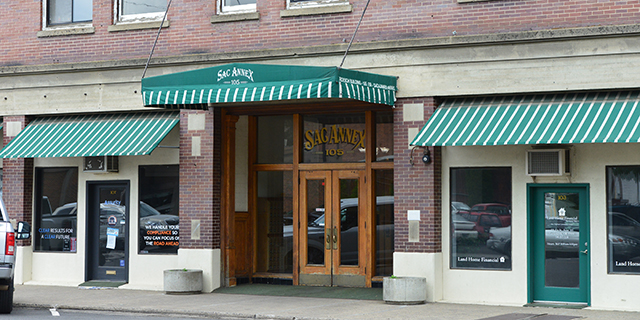News of the weird: Upcycling turns would-be trash into ice cream and pizza
Published 10:08 am Friday, June 23, 2023

- Teresa Chang, left, takes photos as Shuggie's Trash Pie co-owner Kayla Abe brings a Cheddah and Feta Trash Pie pizza to the table at the restaurant in San Francisco, Wednesday, June 14, 2023.
LOS GATOS, Calif. — At Tyler Malek’s ice cream parlors, one cook’s trash is another chef’s frosty treat.
The head ice cream maker at the Portland-based Salt & Straw uses the whey leftover from yogurt makers in upstate New York to make his lemon curd flavor. For chocolate barley milk, he mixes in the remnants of rice and grains from beer brewing to give it a light and creamy taste.
“Instead of calling this food waste, we need to call it wasted food and start decreasing how much wasting we’re doing,” Malek said.
Malek’s ice cream chain is among those at the forefront of the upcycling movement, the process of creating high-quality products from leftover food. Malek’s shops from the Pacific Northwest to Miami now feature flavors like “Cacao Pulp & Chocolate Stracciatella Gelato,” which is made from leftover cacao pulp from chocolate production that otherwise would have gone to waste.
It’s a trend gaining ground as consumers spend more time reading packaging labels and menu ingredients to learn where their food comes from and how it affects the environment. More than 35 million tons of food are wasted every year in the U.S. — about 40% of the country’s food production — costing the national economy more than $200 billion, according to the Upcycled Food Association.
Upcycled food is becoming increasingly common in cake mixes and veggie chips at natural grocery stores. Ingredients include fruits and vegetables from farms nationwide that are perfectly edible but often rejected by restaurants and grocery stores because of their shape or color, like white strawberries, wilted greens and ugly mushrooms.
The Upcycled Food Association, which will celebrated World Upcycling Day on Saturday, June 24, issues an official “Upcycling Certified” seal to qualifying products. These seals, which adorn the new Salt & Straw upcycled flavors, raise awareness with consumers that the company making the food used such ingredients.
The association initially certified about 30 products in 2021 and now has 450 carrying the label.
“A lot of the food that is uneaten or thrown away in our supply chain is actually due to archaic cosmetic standards or sort of perceptions that what we think is edible or quality food,” said Angie Crone, the association’s chief executive. “So this is a mark that you can see on the products wherever you go shopping, to be able to understand how that company is reducing food waste in their supply chain.”
The association’s seal also is featured on all products made by Renewal Mill, an Oakland-based company turning byproducts from plant-based milk into pantry stables like baking flour to reduce waste at the manufacturing level.
“Our first product is the pulp leftover from making soy milk. We turn that into a high fiber gluten-free flour called okara flour,” co-founder Caroline Cotto said. “And then we use that flour to make things like baking mixes and ready-to-eat cookies.”
The company’s okara flour is featured in Salt & Straw’s new “Salted Caramel & Okara Cupcakes” flavor.
The movement isn’t confined to recycled products found in a trendy ice cream store, farmers market or natural grocery. In San Francisco, a restaurant serving pizza and wine focuses on upcycled ingredients such as ugly mushrooms, misshapen peppers and discolored tomatoes, as well as offcuts of meat for menu stars like beef heart meatballs.
“I think so many people think about dumpster diving or using rotten ingredients, but we have this wildly overproductive food system that accounts for a ton of waste,” said Kayla Abe, co-owner of Shuggie’s Trash Pie. “Some people might not read that it’s a beef heart meatball and they just might see meatball. They order it and they’re like, that was the best meatball I’ve ever had in my life.”
Dolphin moms use baby talk to call to their young, recordings show
WASHINGTON — You know instantly when someone is speaking to an infant or small child. It turns out that dolphin mothers also use a kind of high-pitched baby talk.
A study published Monday, June 26, found that female bottlenose dolphins change their tone when addressing their calves. Researchers recorded the signature whistles of 19 mother dolphins in Florida, when accompanied by their young offspring and when swimming alone or with other adults.
The dolphin signature whistle is a unique and important signal — akin to calling out their own name.
“They use these whistles to keep track of each other. They’re periodically saying, ‘I’m here, I’m here’,” said study co-author Laela Sayigh, a Woods Hole Oceanographic Institution marine biologist in Massachusetts.
When directing the signal to their calves, the mother’s whistle pitch is higher and her pitch range is greater than usual, according to the study published in the journal, Proceedings of the National Academy of Sciences.
“That was true for every one of the moms in the study, all 19 of them,” said biologist Peter Tyack, a study co-author from the University of St. Andrews in Scotland.
Obtaining this data was no simple feat. Over more than three decades, scientists placed special microphones multiple times on the same wild dolphin mothers in Florida’s Sarasota Bay to record their signature whistles. That included years when they had calves and when they didn’t — dolphin calves stay with their mothers for an average of three years in Sarasota, and sometimes longer. Fathers don’t play a prolonged role in parenting.
“This is unprecedented, absolutely fantastic data,” said Mauricio Cantor, an Oregon State University marine biologist who was not involved in the study. “This study is the result of so much research effort.”
Why people, dolphins or other creatures use baby talk isn’t certain, but scientists believe it may help offspring learn to pronounce novel sounds. Research dating back to the 1980s suggests that human infants may pay more attention to speech with a greater pitch range. Female rhesus monkeys may alter their calls to attract and hold offspring’s attention. And Zebra finches elevate their pitch and slow down their songs to address chicks, perhaps making it easier to learn birdsong.
For the dolphin study, the researchers focused solely on the signature call, so they don’t know if dolphins also use baby talk for other exchanges — or whether it helps their offspring learn to “talk” as it seems to do with humans.
“It would make sense if there are similar adaptations in bottlenose dolphins — a long lived, highly acoustic species,” where calves must learn to vocalize many sounds to communicate, said Frants Jensen, a behavioral ecologist at Denmark’s Aarhus University and a study co-author.
Another possible reason for using specific pitches is to catch the kids’ attention.
“It’s really important for a calf to know ‘Oh, Mom is talking to me now’ — versus just announcing her presence to someone else,” said Janet Mann, a marine biologist at Georgetown University, who was not involved in the study.









